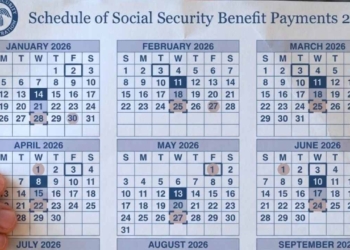For the group of Social Security beneficiaries whose birthdays are between the 11th and 20th of the month and who receive their payments on Wednesday, October 15th, the projected increases for 2026 represent moderate relief, but are significantly offset by rising health care costs. This is the cost-of-living adjustment (COLA) that also applies to other groups.
Payments are also received by those in the group of beneficiaries whose birthdays fall between the 1st and 10th of any month, whose payment is due on Wednesday, October 8th. The third group, those whose birthdays fall after the 21st of any month, whose payment is scheduled for Wednesday, October 22nd.
While the 2.7% increase in benefit checks is a welcome boost, up to 40% of this gain could evaporate due to rising Medicare Part B premiums, leaving many retirees with little net improvement in their purchasing power.
When do Social Security COLA payments increase?
The official COLA for 2026 will be announced by the SSA in October 2025, but consensus projections from groups such as The Senior Citizens League (TSCL) and independent analysts estimate a 2.7% increase. This projection is based on inflation data from the Consumer Price Index for Urban Wage Earners and Clerical Workers (CPI-W) for the third quarter of the year.
What the Bureau of Labor Statistics (BLS) does, which determines the final COLA, is average the cost-of-living increases for July, August, and September of each year and compare it with the same period last year. The percentage difference in the increase becomes the increase.
The current average payment for a retired worker is approximately $2,008 per month. The following table illustrates what the increase would look like for this average beneficiary, followed by a projection for different initial benefit levels.
| Beneficio Mensual Actual (2025) | Aumento COLA 2.7% | Nuevo Beneficio Mensual (2026) |
|---|---|---|
| $1,500 | + $40.50 | $1,540.50 |
| $1,800 | + $48.60 | $1,848.60 |
| $2,008 (Promedio) | + $54.22 | $2,062.22 |
| $2,500 | + $67.50 | $2,567.50 |
| $3,000 | + $81.00 | $3,081.00 |
Medicare Adjustment: The changes coming for beneficiaries
The gross income shown in the table above doesn’t tell the whole story. For the vast majority of retirees, the Medicare Part B premium is automatically deducted from their Social Security benefits. Current projections indicate that this premium will increase significantly in 2026, estimated at $21.50 per month, from $185 to $206.50.
This increase consumes a substantial portion of the COLA. For the average beneficiary, with a $54 increase, almost $22 will immediately go toward covering the higher medical premium, leaving a net gain of approximately $32.50 per month, or $390 annually.
Beyond the COLA and Medicare premiums, other changes will take effect in 2026. For anyone born in 1960 or later, the FRA will officially reach age 67. Claiming benefits before this age will result in a larger permanent reduction than would have been the case in previous years.
Income limits affecting beneficiaries who work before reaching their FRA will also increase. The limit for those below the FRA is projected to be $24,360 annually by 2026.







